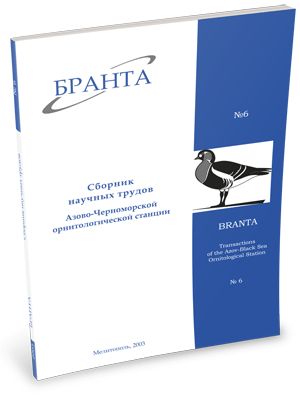
Transactions
of the Azov-Black Sea Ornithological Station



Numbers and distribution of migratory concentrations of Curlews on the south-eastern coast of Karkinitsky bay in 2001 - 2002
Popenko V.M., Chernichko R.N., Kostin S.Yu., Tarina N.A., Bagrikova N.A.
The work was carried out according to the project of Ukrainian Society for Bird Conservation and owing to sponsor support of Bird Life International and UNEP/CMS in 2001-2002.
Material and methods
The area of observations covered the coast of Karkinitsky bay from Kumovskaya plavni in the east to Bakalskaya spit in the west (Fig.1) including sea shoals.
Species composition and number of birds were counted along 6 standard routes. Observations of Curlews were taken from hides at the distance of 60-500 m. Binoculars with 8-20 times magnification and telescopes with 15-40 times magnification were used. Codes of biotopes correspond to Classification of Palearctic habitats following the CORINE typological scheme.
Results
Characteristics of Curlews sojourn on the area. In 2001 Curlews were discovered 192 times in 17 points (Jig-1). 5280 individuals were seen in a total. Out of them 4944 birds were identified as Eurasian Curlews (Numenius arquata (L.). 136 birds as Whimbrels (Numenius phaeopus (L.), 9 birds as Slender-billed Curlews, and 191 birds were not identified as a species (Tables 2, 3, 4).
In 2002 the period of the investigation was shorter. Therefore the number of counted Curlews as well as number of investigated points was less. In a total 1791 birds were registered. There were 1751 Eurasian Curlews, 35 Whimbrels and 5 Slender-billed Curlews.
Eurasian Curlew. Results of Eurasian Curlews census in 2001 are shown in Table 2. Biotopical distribution is in Table 6.
Whimbrel. Results of Whimbrel census in 2001 are shown in Table 3. Biotopical distribution is in Table 6.
Slender-billed Curlew. Results of Slender-billed Curlews census in 2001 are shown in Table 4. Detailed description of each observation is in Table 5.
Distribution of Curlews per biotopes
The characteristic of the basic types of biotopes in which there were marked individual birds or congestions of Numenius has been given. The greatest congestions of Numenius were on open shallows, sandbanks and small bays, where the birds usually spent the night, though frequently remained during the day. On saline lands, where succulent-grassy (Salicomia europaea, Salicomia europaea + Suaeda prostrata, Salicomia europaea + Tripolium vulgare, Salicomia europaea + Puccinella fominii, Salicomia europaea + Halimione pedunculata), semi-schmb (Halocneum strobilaceum + Salicomia europaea), grassy (Artemisia santonica + Salicomia europaea) halophitic communities are growing it was marked less birds, mainly on feeding.
Individual birds were registered very seldom on halophitic meadows, which vegetation is submitted by Artemisia santonica + Limonium caspium or Limonium meyeri, and also on steppe areas, where are in most cases submitted by Artemisia taurica + Bromus sp. + Eremopyrum orientale + Euphorbia seguierana + Carduus sp.
Conclusion
Analysis of Curlews observations for other areas shows that the number of Curlews is much higher in the region of "Lebyazhy Islands" reserve even in comparison with such a big water body as Sivash is. It evidently proves an extreme importance of this area for migratory Curlews. This investigated territory has the following characteristics, providing a high number of Curlews in their migratory period:
- available biotopes;
- protective status of the "Lebyazhy Islands" reserve;
- large amount of an educative work for local population and hunters, carrying out by workers of the Branch of the Crimean Natural Reserve "Lebyazhy Islands" and members of Ukrainian Society for Bird Conservation (non-governmental organization) - an official partner of BirdLife International in Ukraine.
The region is a reliable place of observations of Slender-billed Curlew in autumn. Regular registrations of Slender-billed Curlew in the south of Ukraine (Chemichko, Dudkin, 2002; Yaremchenko, etc.- in printing; Ardamatskaya, etc., 2003) show that the world population of Slender-billed Curlew is a bit higher that it is mentioned in some publications (Vangeluve et al., 2001).
Read the paper in a PDF file